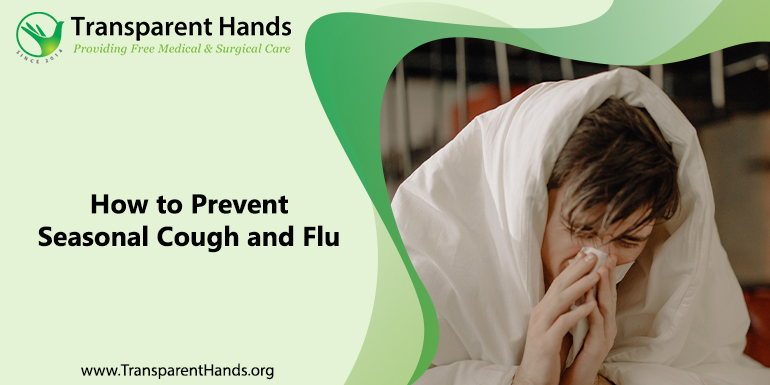Cold & Flu: Prevent Seasonal Ailments

Cold and Flu are viral illnesses. They exhibit several common symptoms and are very contagious. On average, an adult contracts common cold 2 to 3 times in a year and the frequency is even higher in children. Flu also affects millions of adults every year. A large number of these patients need hospitalization and these infections can even cause fatalities.
Let’s take an in-depth look into these viruses and the measures one can take to avoid contracting them.
Common Cold
The common cold is an upper respiratory tract infection that involves the nose and throat. It is caused by a group of viruses known as Rhinoviruses. The infection is usually self-limiting and goes on its own within a week to 10 days.
Symptoms of Common Cold
Patients start experiencing symptoms after one to three days of exposure to the virus. Patients can experience all or some of some these symptoms:
- Runny nose
- Sore throat
- Congestion
- Cough
- Fatigue
- Fever
Nasal discharge keeps changing color during the course of the infection. It starts as a clear fluid but turns yellow or green in the late stages of the infection.
How Can We Control Blood Sugar Levels?
Causes of Common Cold
Rhinoviruses, which cause the common cold, are can be spread by:
- Direct physical contact with infected patients
- Sharing contaminated utensils
- Sharing toiletries
- Sitting close to infected patients
People at High Risk of Contracting Common Cold
Although the common cold can affect individuals of all ages and genders, certain population groups are at a higher risk.
Pediatrics
The immunity of young children and infants is not as strong as adults which puts them at a higher risk of contracting the common cold.
Immunocompromised Patients
Patients taking immunosuppressive medications and those with ailments like HIV have compromised immune systems. Their bodies are unable to cope with infections. This can lead to several conditions.
Asthmatic and COPD Patients
Common Cold can aggravate the symptoms of COPD (chronic obstructive pulmonary disease) and Asthma. Patients may experience increased shortness of breath, fatigue, and cough.
Residents of Cold Areas
While the rhinoviruses circulate round the year, they are more active in winters. Hence, populations living in cold areas are at a higher risk of contracting the common cold.
Smokers
Smokers have reduced lung capacity and their respiratory tract is also likely to undergo degradation. Such individuals experience more intense symptoms than healthy adults when they contract the common cold.
Prevention of Common Cold
Common cold can be prevented by following a few simple tips:
- Regularly wash your hands with soap for at least 20 seconds.
- Disinfect the objects that are routinely used. It is important when one of the family members has contracted the infection. By disinfecting door knobs, light switches, and toiletries, the spread of the common cold can be reduced.
- Do not share the utensils and other objects with the infected person.
- Maintain a distance of six feet from the infected patients while speaking to them.
Flu (Influenza)
Flu is also a viral illness and it infects the respiratory tract. Unlike the common cold, flu can also affect the lungs which are part of the lower respiratory tract. Causative organisms for flu are Influenza viruses that are classified as A, B, C, and D based on their structure and surface protein.
Prevention of Flu
Symptoms of flu are usually more intense compared to the common cold. The preventive tips we discussed for the common cold also apply to flu. While there is no vaccine for the common cold, flu vaccines are available around the world. Flu vaccinations are available at most pharmacies and are usually administered just before the flu season begins in September. Since influenza viruses tend to mutate, new vaccines are produced every year. It significantly reduces the chances of contracting flu, and even if you do, the symptoms are not as intense.
Antibiotics
Antibiotics are only effective against bacteria and do not work against viruses. Thus, antibiotics should only be taken on the advice of healthcare professionals.
Should You See a Doctor For the Common Cold and Flu?
Common cold and Flu are generally self-limiting conditions and resolve on their own. However, the persistence of symptoms after 10 days is a sign of concern and indicates there might be a bacterial infection. In these cases, patients should seek advice from healthcare professionals to get proper treatment.
You should consult a doctor when you experience:
- Severe sore throat
- Heavy mucus discharge
- Trouble in breathing
- Fainting
- Or have other chronic health conditions like diabetes, hypertension, or a weakened immune system
Bottom Line
While the common cold and flu affect millions of people every year, they are usually not very serious ailments for healthy individuals. They can also be easily avoided with a few preventive measures and by getting vaccinated. Patients who deserve our more immediate attention are the ones struggling with life-threatening illnesses. Many of them cannot afford the treatments they need. Transparent Hands is working to provide treatments to such deserving patients free of cost. Your generosity can save lives. Donate now.










Leave a Reply